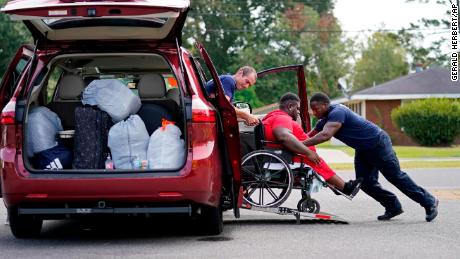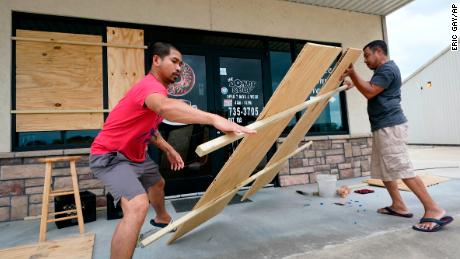Hurricane Laura hit the Louisiana coastline with an intensity the region has not seen in over a century
Laura made landfall near Cameron, Louisiana, as a Category 4 storm with winds of 150 mph, putting it in a tie with a hurricane from more than 160 years ago for the strongest storm to hit Louisiana. The “Last Island Hurricane” of 1856 also had winds of 150 mph when it made landfall in Louisiana.
Hours before Laura’s landfall, water levels along the coast rose rapidly as forecasters warned of an “unsurvivable” storm surge of up to 20 feet and devastating winds. Louisiana Gov. John Bel Edwards predicted parts of his state will be submerged.
“The surge is going to inland … there will be parts of Lake Charles underwater that no living human being has ever seen before,” he told WWL Radio. “We are marshaling all of our people and assets to go in … and start a very robust search and rescue effort.”
The storm made landfall nearly the same week as Hurricane Katrina 15 years ago. Katrina was a Category 5 while it was over the Gulf of Mexico — but was downgraded to a Category 3 by the time it made landfall.
Latest developments
Coronavirus complications: The storm is complicating evacuations in the midst of a pandemic. Due to safety concerns associated with the coronavirus outbreak, officials are opening congregate shelters only as a last resort. States and parishes were lining up noncongregate options, such as hotel rooms, for evacuees, said Mike Steele, a spokesman for the state’s office of Homeland Security and Emergency Preparedness.
Extended storm surge: The storm surge for Laura could spread up to 30 miles inland in southwest Louisiana and Southeast Texas — reaching all the way to Interstate 10 potentially between Beaumont and Lake Charles.
Record storm: Laura is the seventh named storm to make landfall in the US so far this year, a record for the most to do so before the end of August. There have been four tropical storms and three hurricanes.
Hope and prayers: Some first responders in Louisiana’s Natchitoches Parish stood outside the sheriff’s office for a moment of prayers ahead of the hurricane Wednesday.
Tens of thousands at risk of flooding
Calcasieu Parish, where the city of Lake Charles is located, has about 100,000 residents who are at risk of flooding, parish spokesman Tom Hoefer told CNN.
The focus Thursday will be on saving lives and transporting people to shelters, he said. But the Vermilion Parish Sheriff’s Office said evacuation is key because authorities are concerned about rescue efforts.
“Those choosing to stay and face this very dangerous storm must understand that rescue efforts cannot and will not begin until after storm and surge has passed and it is safe to do so. Please evacuate, and if you choose to stay and we can’t get to you, write your name, address, social security number and next of kin and put it a Ziploc bag in your pocket,” the office said in a statement. “Praying that it does not come to this.”


Lake Charles Fire Department personnel Alvin Taylor, right, and Jeremy Harris, left, assist Tim Williams into a transport van as he evacuates Lake Charles.
150 residents refused to leave
Cameron Parish, Louisiana, is under a mandatory evacuation, but out of 6,500 residents, 150 have refused to leave, said Ashley Buller, assistant director of Emergency Operations for the parish.
Sheriff deputies went door-to-door to encourage people to leave, and even the Cameron Parish Office of Emergency Preparedness evacuated.
Travel trailers have been left behind by construction workers on LNG projects. Authorities are concerned about the permanent residents who stayed, Buller said. There have already been reports of water coming up the road.
“We have never experienced anything like this in our history,” Buller said. The hurricane would be their third major storm to strike Cameron Parish in the last 15 years, Hurricane Rita and Hurricane Ike were the other two. Buller says Hurricane Ike caused the biggest flooding, “It moved water into the northern portions of the parish that we didn’t see from Rita.”
She expects Hurricane Laura to be worse.
“My family has evacuated,” noted the assistant director of emergency preparedness. “They are two and a half hours to the Northeast. I needed them as far away from this as possible.”


Daoith Porm, left, and Bunsant Khov, right, board their business with Hurricane Laura just hours away.
Time to take shelter
Storm surge reaching about 20 feet could be among Laura’s greatest threats along with winds that have prompted a rare “extreme wind warning” for Lake Charles, Beaumont, Port Arthur and other nearby locations.
Extreme Wind Warnings are issued when winds that are not associated with a tornado or other thunderstorm event are expected to exceed 115 mph, such as in a major hurricane. Residents under the warning are warned to “take cover now and to treat these imminent extreme winds as if a tornado was approaching and move immediately to the safe room in your shelter.”
Taking shelter is even more important after Bel Edwards closed a section of I-10, the east-west interstate that connects much of the Gulf Coast, as Hurricane Laura gets closer.
“I-10 eastbound is closed at the Texas/Louisiana state line, and I-10 westbound is closed west of the Atchafalaya Basin,” the governor tweeted Wednesday night.
The closures cover roughly the western half of the interstate.
CNN’s Brandon Miller, Joe Sutton, Andy Rose and Dave Alsup contributed to this report.
![]()


